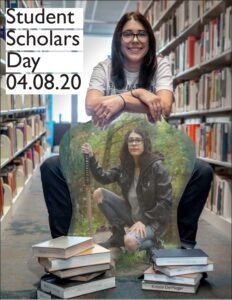In “A Library Journey,” Kate sets off on the research process and finds adventure along the way. Originally conceptualized as an extension of the Library Summer Scholars Program and research conducted on the Monomyth, this genre experiment builds on the flyer submission form for the Office of Undergraduate Research and Scholarships’ Student Scholars Day 2020 call for art. A piece of work based on the premise that anyone can start on the journey to research, they simply must answer the call, this piece is a creative writing envisioning of the hero’s journey and the research process.
The original genre is the form of a flyer. It features a design intended to convey the spirit of the research journey. A female GVSU student (me) is featured sitting in the stacks of Mary Pew Idema Library. Her arms are casually crossed over an antique mirror; stacks of books bearing the GVSU libraries stamp are piled at her feet. The mirror’s reflection displays another worldly image; the same scholar kneeling on a tree trunk in the woods, leaning on a katana.
The intention behind the image was to show that anyone can be a scholar, and further, find their hero’s journey. The project evolved naturally; my research project consisted of creating a subject guide for the GVSU library, then connecting that research on the monomyth to my summer research experience. Later, during the fall, I turned the content of that speech into both a poster and an audio essay. I also created a blog post, introducing the material. While I have applied the hero’s journey to my own creative fiction, I’ve never written from this angle before.
My aim, or what I wish to accomplish, is to create a narrative that shows a different perspective of what undergraduate research can be. Often research is viewed as unexciting work, but I believe with the right topic it can be more. Scholarly research changed my career path and gave me an edge on my peers. I’ve gained a sense of belonging through my involvement with their programs. Secondly, I haven’t written creative fiction in some time, and I miss it. I think a fantastical romp through the stacks is long overdue, and wouldn’t it be interesting to deliberately follow the Monomyth’s structure? I’m also interested in how the process works to write about the research and the hero’s journey but without the typical phrasings and framing of the monomyth’s language.
What if our hero were to fall into a dream of the research topic? Deep analysis can leave you feeling as if you had. Can an everyday undergraduate research scholar be a hero? Can they find the strength of Alice falling through the rabbit hole, or Dorothy, riding through the tornado to an uncertain destination? The goal of the monomyth’s hero is to set out on an adventure, face a crisis, and return victorious. In many ways it has ties to a coming of age or identity story; our researcher finds security and personhood through the skills gained in the program, as well as through the encounter with her research topic, in the wild, so to speak.


